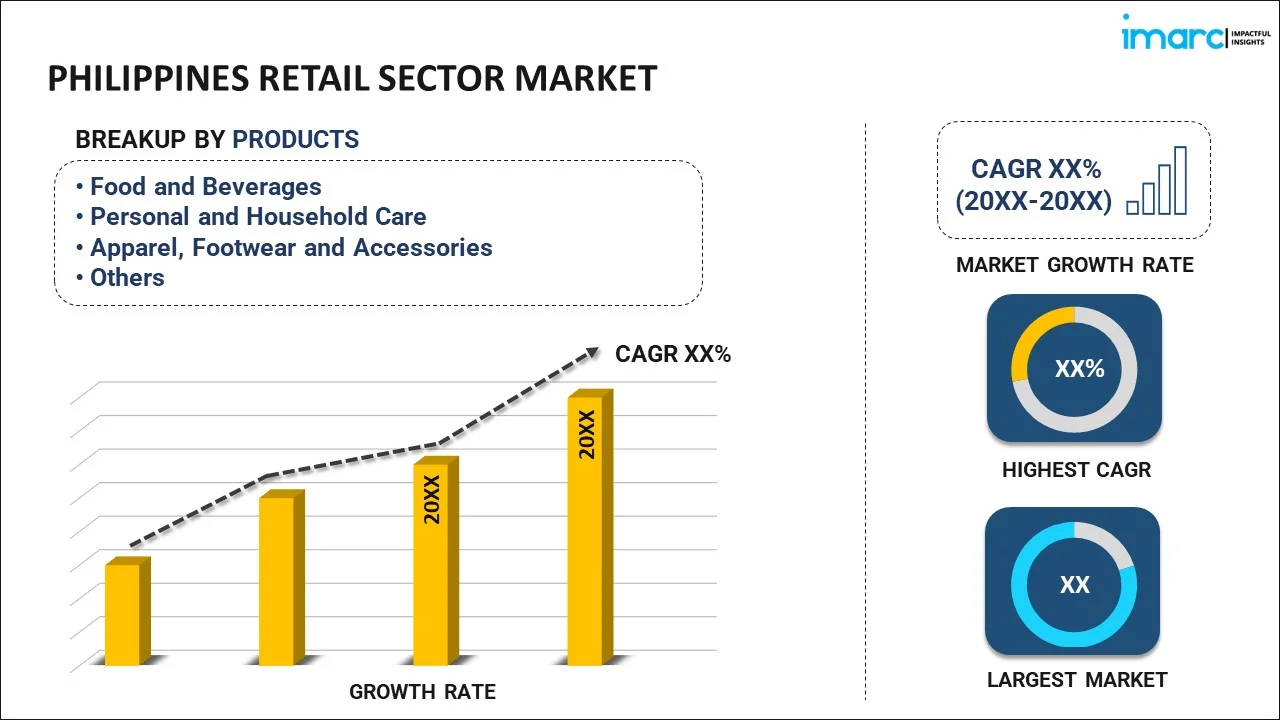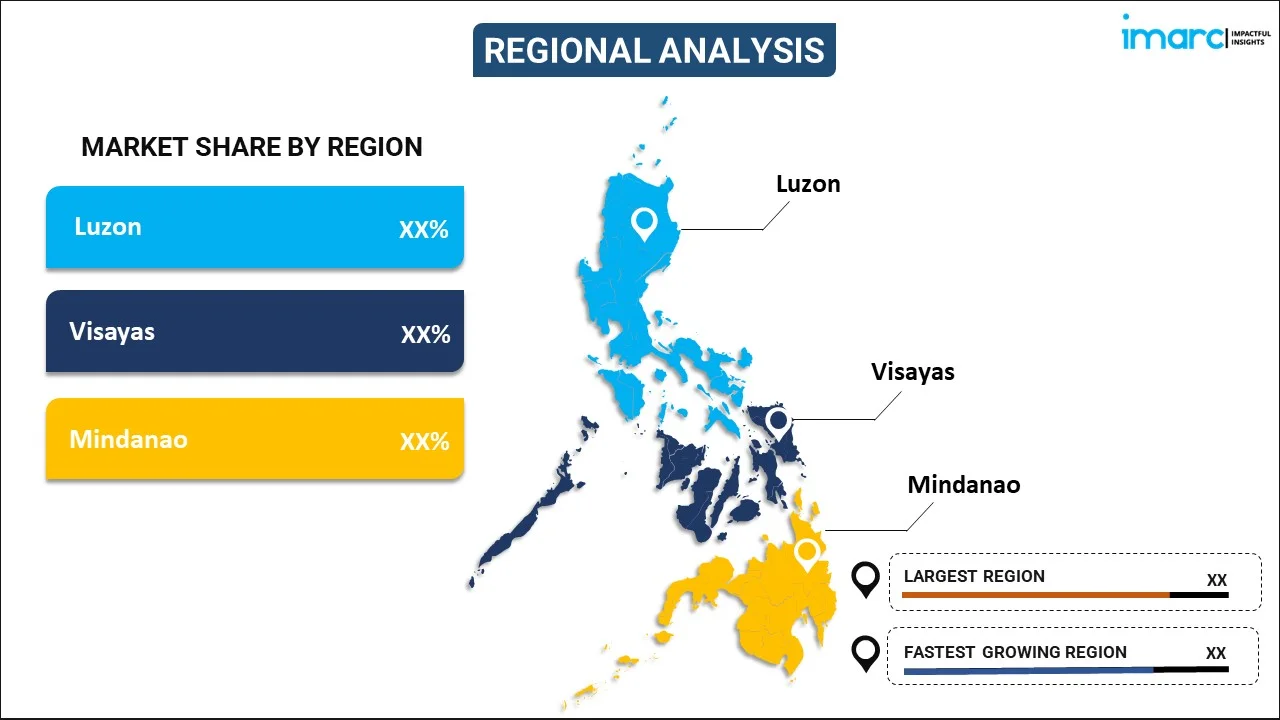
Philippines Retail Sector Market Report by Product (Food and Beverages, Personal and Household Care, Apparel, Footwear and Accessories, Furniture, Toys and Hobby, Electronic and Household Appliances, and Others), Distribution Channel (Supermarkets and Hypermarkets, Convenience Stores, Specialty Stores, Online Stores, and Others), and Region 2025-2033
Philippines Retail Sector Market Overview:
The Philippines retail sector market size is projected to exhibit a growth rate (CAGR) of 7.7% during 2025-2033. The increasing consumer spending, e-commerce expansion, technological advancements, urbanization, improved supply chain management, rising disposable incomes, enhanced customer experiences, globalization, and strategic partnerships among retailers are the main drivers influencing the market growth.
|
Report Attribute
|
Key Statistics
|
|---|---|
|
Base Year
|
2024 |
|
Forecast Years
|
2025-2033 |
|
Historical Years
|
2019-2024
|
| Market Growth Rate (2025-2033) | 7.7% |
Philippines Retail Sector Market Trends:
Rise of e-commerce:
Online shopping has surged due to its convenience, vast product selection, and competitive pricing. In 2021, smartphone household penetration in the Philippines rose to 74.1%, marking a 2% increase from 2020. Consumers increasingly prefer to shop from the comfort of their homes, leading to a decline in traditional brick-and-mortar stores. Lockdowns and other social distancing measures brought on by the COVID-19 pandemic hastened this change by forcing people to shop online for both necessities and non-essentials. Furthermore, e-money users surged more than fourfold, climbing from 8% in 2019 to 36% in 2021, which further bolstered the market growth. Moreover, retailers are responding by expanding their digital presence, investing in user-friendly websites, and enhancing their online offerings, thus propelling the market forward.
Integration of advanced technologies:
Retailers are adopting technologies such as artificial intelligence (AI), machine learning (ML), and big data analytics to gain insights into consumer behavior, optimize inventory management, and enhance operational efficiency, which is creating a positive outlook for market expansion. AI-powered chatbots and virtual assistants are being used to provide instant customer support and personalized recommendations, improving the overall shopping experience. In line with this, according to Microsoft Philippines, Filipinos are at the forefront of AI adoption, with an impressive 86% of knowledge workers integrating AI into their daily work routines. This percentage exceeds both the global average of 75% and the regional average of 83%. Moreover, customers can now see products in real-world environments before making a purchase due to the use of augmented reality (AR) and virtual reality (VR) technologies in immersive shopping experiences, which is fueling the market growth.
Increasing emphasis on personalized customer experiences:
Modern consumers expect retailers to understand their preferences and deliver tailored experiences. As a result, retailers are using data analytics to segment their customer base and offer personalized product recommendations, promotions, and marketing messages. Concurrently, they are introducing loyalty programs in order to reward consumers based on their purchasing patterns as this promotes repeat business and strengthens brand loyalty. In-store experiences are also being personalized, with retailers using location-based technologies such as beacons to deliver targeted offers and information to customers' smartphones as they shop. Additionally, the rise of omnichannel retailing providing consumers with a seamless and integrated shopping experience across multiple touchpoints, including online, mobile, and in-store is impelling the market growth.
Philippines Retail Sector Market News:
- In January 2024, Rose Pharmacy, a major player in the Philippine healthcare retail sector, celebrated a significant milestone with the opening of its 400th store. In addition to a wide range of medicines, the store features products from Guardian, a leading Southeast Asian health and wellness brand.
- In January 2024, Robinsons Retail and DFI Retail collaborated to launch Meadows, a brand known for its high-end assortment of food and beverage (F&B), kitchen and home essentials, and international health and beauty products. Meadows made its debut in the Philippines with a flagship store at Shopwise, Paraguay City, emphasizing its dedication to providing unbeatable value.
Philippines Retail Sector Market Segmentation:
IMARC Group provides an analysis of the key trends in each segment of the market, along with forecasts at the country level for 2025-2033. Our report has categorized the market based on product and distribution channel.
Product Insights:

- Food and Beverages
- Personal and Household Care
- Apparel, Footwear and Accessories
- Furniture, Toys and Hobby
- Electronic and Household Appliances
- Others
The report has provided a detailed breakup and analysis of the market based on the product. This includes food and beverages, personal and household care, apparel, footwear and accessories, furniture, toys and hobby, electronic and household appliances, and others.
Distribution Channel Insights:
- Supermarkets and Hypermarkets
- Convenience Stores
- Specialty Stores
- Online Stores
- Others
A detailed breakup and analysis of the market based on the distribution channel have also been provided in the report. This includes supermarkets and hypermarkets, convenience stores, specialty stores, online stores, and others.
Regional Insights:

- Luzon
- Visayas
- Mindanao
The report has also provided a comprehensive analysis of all the major regional markets, which include Luzon, Visayas, and Mindanao.
Competitive Landscape:
The market research report has also provided a comprehensive analysis of the competitive landscape. Competitive analysis such as market structure, key player positioning, top winning strategies, competitive dashboard, and company evaluation quadrant has been covered in the report. Also, detailed profiles of all major companies have been provided.
Philippines Retail Sector Market Report Coverage:
| Report Features | Details |
|---|---|
| Base Year of the Analysis | 2024 |
| Historical Period | 2019-2024 |
| Forecast Period | 2025-2033 |
| Units | Billion USD |
| Scope of the Report | Exploration of Historical and Forecast Trends, Industry Catalysts and Challenges, Segment-Wise Historical and Predictive Market Assessment:
|
| Products Covered | Food and Beverages, Personal and Household Care, Apparel, Footwear and Accessories, Furniture, Toys and Hobby, Electronic and Household Appliances, Others |
| Distribution Channels Covered | Supermarkets and Hypermarkets, Convenience Stores, Specialty Stores, Online Stores, Others |
| Regions Covered | Luzon, Visayas, Mindanao |
| Customization Scope | 10% Free Customization |
| Post-Sale Analyst Support | 10-12 Weeks |
| Delivery Format | PDF and Excel through Email (We can also provide the editable version of the report in PPT/Word format on special request) |
Key Questions Answered in This Report:
- How has the Philippines retail sector market performed so far and how will it perform in the coming years?
- What has been the impact of COVID-19 on the Philippines retail sector market?
- What is the breakup of the Philippines retail sector market on the basis of product?
- What is the breakup of the Philippines retail sector market on the basis of distribution channel?
- What are the various stages in the value chain of the Philippines retail sector market?
- What are the key driving factors and challenges in the Philippines retail sector?
- What is the structure of the Philippines retail sector market and who are the key players?
- What is the degree of competition in the Philippines retail sector market?
Key Benefits for Stakeholders:
- IMARC’s industry report offers a comprehensive quantitative analysis of various market segments, historical and current market trends, market forecasts, and dynamics of the Philippines retail sector market from 2019-2033.
- The research report provides the latest information on the market drivers, challenges, and opportunities in the Philippines retail sector market.
- Porter's five forces analysis assist stakeholders in assessing the impact of new entrants, competitive rivalry, supplier power, buyer power, and the threat of substitution. It helps stakeholders to analyze the level of competition within the Philippines retail sector industry and its attractiveness.
- Competitive landscape allows stakeholders to understand their competitive environment and provides an insight into the current positions of key players in the market.
Need more help?
- Speak to our experienced analysts for insights on the current market scenarios.
- Include additional segments and countries to customize the report as per your requirement.
- Gain an unparalleled competitive advantage in your domain by understanding how to utilize the report and positively impacting your operations and revenue.
- For further assistance, please connect with our analysts.
 Inquire Before Buying
Inquire Before Buying
 Speak to an Analyst
Speak to an Analyst
 Request Brochure
Request Brochure
 Request Customization
Request Customization




.webp)




.webp)












